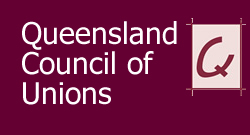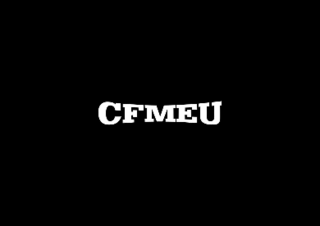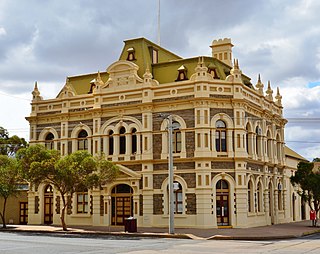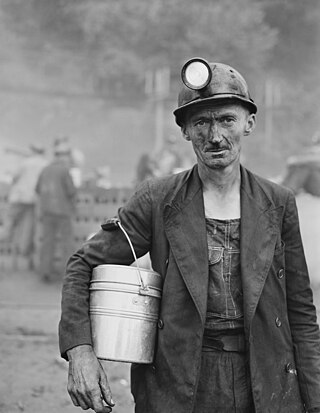Related Research Articles

William Guthrie Spence, was an Australian trade union leader and politician, played a leading role in the formation of both Australia's largest union, the Australian Workers' Union, and the Australian Labor Party.
The Australian Workers' Union (AWU) is one of Australia's largest and oldest trade unions. It traces its origins to unions founded in the pastoral and mining industries in the late 1880s and it currently has approximately 80,000 members. It has exercised an outsized influence on the Australian Trade Union movement and on the Australian Labor Party throughout its history.

The Queensland Council of Unions (QCU) is a representative, an advocacy group, or peak body, of Queensland trade union organisations, also known as a labour council, in the Queensland, Australia. As of 2020, 26 unions and 13 regional branches were affiliated with the QCU. The QCU represents unions covering around 350,000 Queensland workers. It is affiliated with the Australian Council of Trade Unions (ACTU). Its offices are located in the suburb of South Brisbane, Queensland. As a peak body for the Queensland trade unions, the objective of the QCU is to achieve industrial, social and political justice for Queensland workers. The management structure of the QCU is made up of a committee of management and an executive of representatives comprised from affiliated unions.

The Construction, Forestry and Maritime Employees Union (CFMEU) is the largest union in construction, forestry, maritime, textile, clothing and footwear production. The CFMEU is affiliated with the Australian Council of Trade Unions and the Australian Labor Party.

The 1949 Australian coal strike was the first time that Australian military forces were used during peacetime to break a trade union strike. The strike by 23,000 coal miners lasted for seven weeks, from 27 June 1949 to 15 August 1949, with troops being sent in by the Ben Chifley Federal Labor government to the open cut coal mines in New South Wales on 28 July 1949, with the workers returning to work, defeated, two weeks later.

The Irish Transport and General Workers Union (ITGWU) was a trade union representing workers, initially mainly labourers, in Ireland.
Black Friday, in British labour history, refers to 15 April 1921, when the leaders of transport and rail unions announced a decision not to call for strike action in support of the miners. The epithet 'black' derives from a widespread feeling amongst labour radicals that the decision amounted to a breach of solidarity and a betrayal of the miners.
The following is a timeline of labor history, organizing & conflicts, from the early 1600s to present.
The Miners' Federation of Great Britain (MFGB) was established after a meeting of local mining trade unions in Newport, Wales in 1888. The federation was formed to represent and co-ordinate the affairs of local and regional miners' unions in England, Scotland and Wales whose associations remained largely autonomous. At its peak, the federation represented nearly one million workers. It was reorganised into the National Union of Mineworkers in 1945.

The Barrier Industrial Council is the trades and labour council in Broken Hill, New South Wales, Australia, and surrounding areas. Formed in 1923 by 18 trade unions, the council has been unusually influential in local government, for a labour confederation. The BIC also owns the only newspaper based in Broken Hill, the Barrier Daily Truth.

William Edward Parry was a New Zealand politician and trade unionist.
Manufacturing Grocers' Employees' Federation of Australia (M.G.U.) was an Australian trade union existing between 1906 and 1988. The union was first established as the Federated Candle, Soap, Soda & Starch Employees' Union of Australia, before changing its name in 1914. The union represented workers employed in manufacturing grocers' sundries and non-edible grocery products, particularly in the southern states of South Australia and Victoria. In 1988 the union amalgamated with the Federated Millers and Mill Employees' Union to form the Federated Millers and Manufacturing Grocers Employees' Association of Australia, which in turn merged with a number of unions to form the National Union of Workers.
Peter Bowling was an Australian coal miner and trade unionist.
The Northern Rhodesian African Mineworkers' Union (A.M.U.) was a trade union in Northern Rhodesia which represented black African miners in the Copperbelt. The AMU was formed in 1949, and campaigned actively to improve working conditions and wages for African miners, as well as opposing racial discrimination in hiring. The union amalgamated with several other mining unions in 1967 to form the Mineworkers' Union of Zambia.

The Federated Ironworkers' Association of Australia (FIA) was an Australian trade union which existed between 1911 and 1991. It represented labourers and semi-skilled workers employed in the steel industry and ironworking, and later also the chemical industry.

People have worked as coal miners for centuries, but they became increasingly important during the Industrial revolution when coal was burnt on a large scale to fuel stationary and locomotive engines and heat buildings. Owing to coal's strategic role as a primary fuel, coal miners have figured strongly in labor and political movements since that time.
The History of trade unions in the United Kingdom covers British trade union organisation, activity, ideas, politics, and impact, from the early 19th century to the recent past. For current status see Trade unions in the United Kingdom.
James Comerford was an Australian trade unionist, activist, writer and miner who was national general secretary of the Australian Coal and Shale Employees' Federation and served as its Northern New South Wales president from 1953 to 1973.
The Mining and Energy Union (MEU) is Australia's main trade union in the coal industry including mines, power stations and ports. It also covers workers in the metalliferous mining and exploration industries, as well as specific classes of workers working in the oil, gas, nuclear chemical production and power generation industries. The MEU is affiliated with the Australian Council of Trade Unions (ACTU) and the Australian Labor Party (ALP).
References
- 1 2 3 "Australasian Coal & Shale Employees Federation (1916 - 1990)". Australian Trade Union Archives. Retrieved 30 July 2018.
- ↑ "ORGANISATION OF EMPLOYES". Bendigo Advertiser . Vol. LXIV, no. 18, 882. Victoria, Australia. 18 February 1916. p. 3. Retrieved 30 July 2018– via National Library of Australia.
- 1 2 Walker, Kenneth Frederick (1970). Australian Industrial Relations Systems . Harvard University Press. pp. 333.
- ↑ ATUA Project Team, University of Melbourne Archives. "Amalgamated Miners Association of Australasia - Trade Union entry - Australian Trade Union Archives". ISBN 0908029497 . Retrieved 22 January 2023.
- ↑ "Workers' Industrial Union of Australia (WIUA) (1919 - 1921)". Reason in Revolt. Retrieved 30 July 2018.
- ↑ Bowden, Bradley (2011). "The rise and decline of Australian unionism: a history of industrial labour from the 1820s to 2010" (PDF). Labour History (100): 64.
- ↑ Blake, Jack. "The 1949 Coal Strike". Australian Left Review. 70: 12–18.